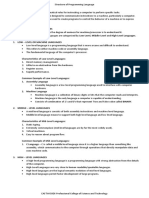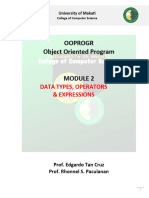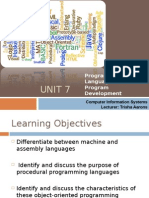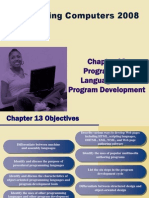0 ratings0% found this document useful (0 votes)
4 viewsBasic Programming Research
The document outlines the program development cycle, which includes five phases: Analyzing, Designing, Coding, Debugging and Testing, and Implementing and Maintaining Application Software. It explains the distinction between low-level and high-level programming languages, emphasizing their roles in communication with computers and software development. Additionally, it describes Visual Basic as an event-driven programming language with a user-friendly interface and details the components of the Visual Basic 6.0 environment.
Uploaded by
Micah CortesCopyright
© © All Rights Reserved
Available Formats
Download as DOCX, PDF, TXT or read online on Scribd
0 ratings0% found this document useful (0 votes)
4 viewsBasic Programming Research
The document outlines the program development cycle, which includes five phases: Analyzing, Designing, Coding, Debugging and Testing, and Implementing and Maintaining Application Software. It explains the distinction between low-level and high-level programming languages, emphasizing their roles in communication with computers and software development. Additionally, it describes Visual Basic as an event-driven programming language with a user-friendly interface and details the components of the Visual Basic 6.0 environment.
Uploaded by
Micah CortesCopyright
© © All Rights Reserved
Available Formats
Download as DOCX, PDF, TXT or read online on Scribd
You are on page 1/ 1
Basic Programming Research
Micah Cortes
1. What is the program development cycle, and what are its phases?
- The PLDC has 5 phases, which are: Analyzing, Designing,
Coding, Debugging and Testing, and Implementing and
Maintaining Application Software.
2. What is a programming language?
A. Low-Level Languages
- Provides little or no abstraction from a computer’s instruction set
architecture; commands or functions in the language are
structurally similar to a processor’s instructions. Low-Level
languages can convert to machine code without a complier or
interpreter-second-generation programming languages.
B. High-level language
- Has strong abstract from the details of the computer. In contrast
to Low-Level programming languages, it may use natural
language elements. Rather than dealing with registers, memory
addresses, and call stacks, high-level languages deal with
variables, arrays, objects, and etc.
3. Why is programming language important?
- They allow us to communicate with computers, create
applications, and build software. It also helps us to automate
tasks, and solve complex problems.
4. What is visual basic?
- A event-driven programming language and environment from
Microsoft that provides a graphical user interface which allows
programmers to modify code by simply dragging and dropping
objects. Intended to be easy to learn and fast to write code with.
5. What are the parts and functions of the Visual Basic 6.0
Environment?
- Features integrated development environment with multiple
windows and components for designing, writing, and testing
applications.
You might also like
- Chapter-2-Computer Science-10 Class-Federal Board100% (2)Chapter-2-Computer Science-10 Class-Federal Board19 pages
- Programming Language _ What is Programming Language - JavatpointNo ratings yetProgramming Language _ What is Programming Language - Javatpoint22 pages
- Module 1 - COSC95 - Introduction To Programming Languages - VCBNo ratings yetModule 1 - COSC95 - Introduction To Programming Languages - VCB11 pages
- Supervised By: Dr. Abdullbast Ali Prepared By: Sahar Talb: Programming LanguageNo ratings yetSupervised By: Dr. Abdullbast Ali Prepared By: Sahar Talb: Programming Language13 pages
- Chapter One: Introduction Programming LanguagesNo ratings yetChapter One: Introduction Programming Languages18 pages
- Lesson 1 Introduction to Basic Progrogramming ConceptsNo ratings yetLesson 1 Introduction to Basic Progrogramming Concepts31 pages
- Programming Languages and Program Development100% (1)Programming Languages and Program Development50 pages
- Integrative Programming and Technologies 1No ratings yetIntegrative Programming and Technologies 128 pages
- Difference Between High Level Language and Low Level LanguageNo ratings yetDifference Between High Level Language and Low Level Language9 pages
- Meeting 8 - SI - TI - Programming LanguageNo ratings yetMeeting 8 - SI - TI - Programming Language4 pages
- IT Technologies Cheet Sheet For RecruitersNo ratings yetIT Technologies Cheet Sheet For Recruiters18 pages
- Types of Programming Languages: 1. Low Level LanguageNo ratings yetTypes of Programming Languages: 1. Low Level Language14 pages
- Discovering Computers 2008: Programming Languages and Program DevelopmentNo ratings yetDiscovering Computers 2008: Programming Languages and Program Development54 pages
- Topic 1. Overview of Programming LanguagesNo ratings yetTopic 1. Overview of Programming Languages6 pages
- Chapter One: Department of Software Eng Fundamentals of Programming INo ratings yetChapter One: Department of Software Eng Fundamentals of Programming I10 pages
- PROGRAMMING LANGUAGES NOTES ICT and COMPUTERNo ratings yetPROGRAMMING LANGUAGES NOTES ICT and COMPUTER66 pages
- Programming: in This Lesson Students WillNo ratings yetProgramming: in This Lesson Students Will8 pages



























































